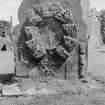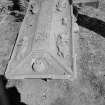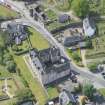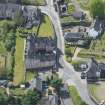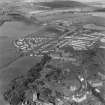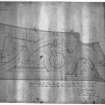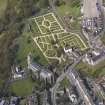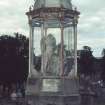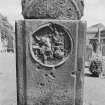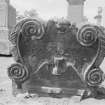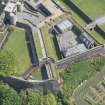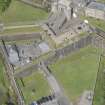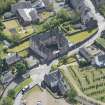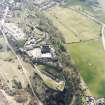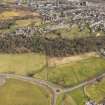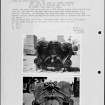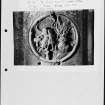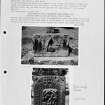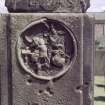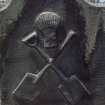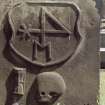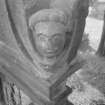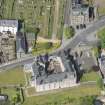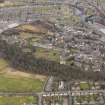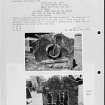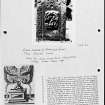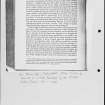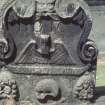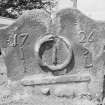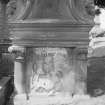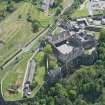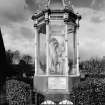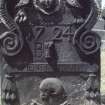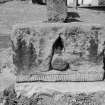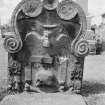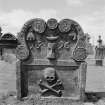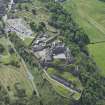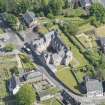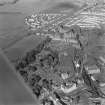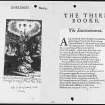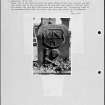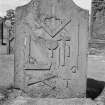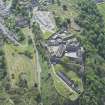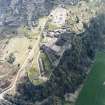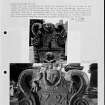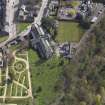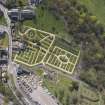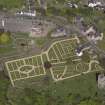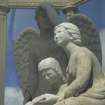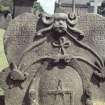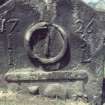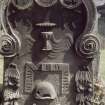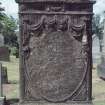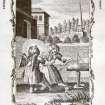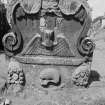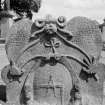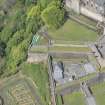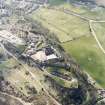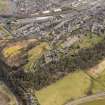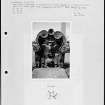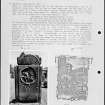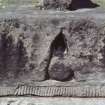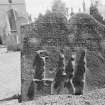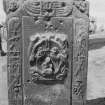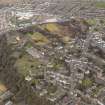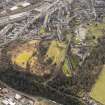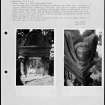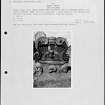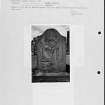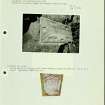Stirling, St John Street, Church Of The Holy Rude, Burial-ground
Burial Ground (16th Century)
Site Name Stirling, St John Street, Church Of The Holy Rude, Burial-ground
Classification Burial Ground (16th Century)
Alternative Name(s) Holy Rood Church; Valley Cemetery; Greyfriars Churchyard
Canmore ID 74540
Site Number NS79SE 39.01
NGR NS 79175 93778
Datum OSGB36 - NGR
Permalink http://canmore.org.uk/site/74540
- Council Stirling
- Parish Stirling
- Former Region Central
- Former District Stirling
- Former County Stirlingshire
NS79SE 39.01 79175 93778
NS 792 937. A watching brief undertaken during the installation of floodlighting around the Church of the Holy Rude in Stirling, in September 1993, revealed no structural remains. A small quantity of very disturbed hurnan bone was reburied in the adjoining graveyard.
Sponsor: Central Regional Council.
L Main 1994d.
Field Visit (1953 - 1958)
In the Graveyard.
The following are the only monuments bearing legible dates earlier than 1707, though it may be taken as certain that a number of other slabs, on which no design or lettering can now be made out, must date from the 17th century.
(1) The Sconce family memorial. This is a Renaissance wall-monument comprising base, body and pediment, measuring 13 ft. in height, 14 ft. in width across the base and 8 ft. 6 in. across the body. From pedestals set out from the base, which is flanked by ornate consoles, there rise two double columns to support a shaped pediment with a moulded cornice and, in its centre, a cherub with swags of fruit and flowers dividing the date 16[89] (endnote 1). Between the columns there is an inscribed panel with a moulded margin, flanked by decorative strap-work and emblems of mortality. Above are two angels. Much of the original inscription on the panel has perished, but it can be restored as follows with the help of a metal plaque (en.2) which was fixed to the side of the monument, for purposes of record, in 1936: [HERE LIES THE CORPSE OF / IOHN MCCULLOCH LEAT PROVO]ST OF STIRLING / [WHO] DIED THE 5 OF OCTOBER / 1689 YEARS OF AGE [54 / REVELATIONS 14 VERSE 13] /BLESED (sic) ARE THE DEAD WHO / DIE IN THE LORD THAT THEY / MAY REST FROM THEIR LABOUR[S] /AND THEIR WORKS DO FOLLOW THEM /
ULTIMA SEMPER /
EXPECTANDA DIES HOMINI / DICIQUE BEATUS /ANTE OBITUM NEMO SUPREMA[QUE] / FUNERA DEBET
("We must always await life's last day, and no one should be called happy until he is dead and buried".) (en.3)
Below the original inscription there has been added, in large cursive script, 1729 / JOHN SCONCE / CHRISTIAN LUCKISON; 19th-century inscriptions appear on the base of the monument.
(2) A large ornate headstone dated 1701 and commemorating IOHN PATON IANET /PARK IOHN PATON / ALEXR PAT ON / IANET TOUAR.
(3) A slab, bearing in high relief a shield-shaped panel and, below this, trade emblems which suggest a miner or quarryman-pick, mallet and chisel. The panel bears a shield charged, for Gibb: In chief, a broken spear chevronwise, held by a hand issuing from the sinister; in base a spur. Above the shield is incised the date 1579. The original dedication appears to have been erased, and on the cut-down surface there is now an incised inscription commemorating James Gibb, who died in 1810.
(4) A headstone, the top of which has been reshaped in such a way that part of the date has been removed. The inscription now reads [1]67[?3] / I WM C / I W B G / R W I C / R W C D.
(5) A similar headstone, reshaped in the same way and bearing the same initials as (4).
(6) An ornate headstone dated 1698 and commemorating T T and I G. A later inscription appears on the other side.
(7) A large slab inscribed at the top HERE LIES THE CORPS OF / ANDREW BAIRD BAILLIE IN / STIRLING WHO DIED 24 IUNE 1692 / AGED 77. MARGARAT SWORD HIS / SPOUSE DIED 28 MARCH 1677. Initials follow, and then an 18th-century inscription containing names which correspond with some of them, and this fact suggests that the whole may actually date from after 1707 notwithstanding the early appearance of the original inscription as recorded.
(8) A headstone bearing the date 1705, divided by the crowned rounding-knife of the Cordiners, and commemorating P D M D. Below are funerary emblems with the motto SURGITE VENITE ("Arise, come").
(9) A slab bearing, on a shield, the date 1699 and the initials IS [?] Mover a merchant's mark. The name Stevenson occurs in later inscriptions.
(10) A large ornate headstone inscribed 1700 / I C J D.
(11) A slab on which the primary inscription consists of the date 1700 above a shield, the initials W M / M H divided by the shield, and below it W F E K / w M M W / W S J H. The shield is charged: A weaver's shuttle.
(12) A headstone with a primary date 1696 in relief. Other dates, later than1707, and names which follow are incised.
(13) A tabletomb dated 1687 with a contemporary merchant's mark, but "renewed", according to a later inscription, in 1848.
(14) A large ornate headstone, partly earthed up. On the exposed part can be read I F 1703 D F / I CIF.
(15) A large headstone set in a masonry base, and with a separate semicircular top, the latter damaged (PI. 47 B). Both faces show bullet-marks, and the E. one bears a central panel flanked by fluted strips decorated with mason's tools and, at the top, what seems to be a reversing monogram. On the panel there is an assemblage of drapery and strap-work, with a figure seated on a crescent or scroll in the centre. Above the assemblage there is a weathered and damaged inscription of which little can now be deciphered. The first four lines were probably pious verse, and these are followed by IOHN SERVICE OBIIT … [S]EP [TEM]BER ANNO DOM(INI) 16[?97] / AETATIS VERO 74 / HIS SPOVS BE[?SSI]E BVINE. In the later 19th century the date seems to have been read as 1629 (en.4), but 1697 is almost certainly correct. A second inscription, below the assemblage, is illegible. The separate top portion bears, on this face, an archangel with a trumpet, rising from clouds, and on the other a shield, dividing the initials I S and bearing what seems to be a monogram. The main decoration on the W. face is a cartouche formed by a snake with its tail in its mouth and containing a group of three figures, one of them haloed, and a tree (en.5). Illegible texts issue from the mouths of two of them.
The following monuments, though of later date than 1707, also deserve to be mentioned as being typical of the taste and sentiments of their day.
(1) [NS79SE 39.03] A group of marble figures comprising two girls and an angel, protected by a casing of glass and iron, with the inscription MARGARET / VIRGIN MARTYR OF THEOCEAN WAVE / WITH HER LIKE-MINDED SISTER /AGNES. On the evidence of her tombstone in Wigtown Churchyard (en.6), Margaret Wilson was martyred by drowning, as a Covenanter, in 1685; but the whole episode has been the subject of controversy. The monument was erected by the late William Drummond, Stirling, about 1870.
(2) A life-sized statue of the Reverend Ebenezer Erskine, erected in 18584 (en.7) and bearing his name only.
(3) [NS79SE 39.02] A pyramid of grey ashlar bearing Biblical texts and white marble decorations. This is a memorial to all those who suffered martyrdom in Scotland in the cause of civil and religious liberty (en.8), and was erected by the same William Drummond mentioned above.
RCAHMS 1963, visited between 1953 and 1958
Endnotes:
(1) The two latter figures were covered with ivy at the date of visit, but may be supplied from the main inscription.
(2) Close examination of the wasted lettering shows that the version given on the plaque differs from the original in its setting-out and in a few other minor respects.
(3) These verses (Ovid, Metamorphoses, iii, 135 ff.) also appear on the Paton monument (1676) in Greyfriars churchyard, Edinburgh (Inventory of Edinburgh, p. 64), and on a slab (1702) in the parish churchyard of Peebles
(4) P.S.A.S., xxxvi (1901-2), 367.
(5) Illustration, ibid.
(6) Inventory of Wigtownshire, No. 523
(7) Rogers, Scottish Monuments and Tombstones, ii, 40. On Erskine see RCAHMS 1963 p. 8 above.
(8) Rogers, op. cit., 41
Photographic Survey (1985)
Recording of gravestones in the burial ground of Church of the Holy Rude, Stilring, by Mrs Betty Willsher in 1985.























































































